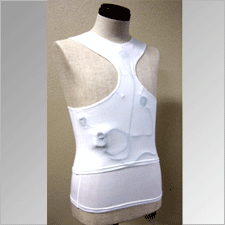Deployment of Medical Applications for "hitoe": Functional Material for Measuring Biomedical Signals

Nippon Telegraph and Telephone Corporation (NTT) and Toray Industries, Ltd. (Toray) are pursuing development of ECG measurement technologies that meet stringent safety and efficiency standards for medical devices with the end goal of opening up applications for “hitoe”, a functional material capable of transmitting biomedical signals, in the medical field. Based on these collaborative initiative, Toray Group and NTT have successfully registered a single-use electrode for ECG hitoe medical electrode (General Medical Device, MD Notification number: 13B1X00015000031) and a dedicated ECG cable plus lead hitoe medical lead (General Medical Device, MD Notification number: 13B1X00015000032) with the Pharmaceuticals and Medical Devices Agency on August 10, 2016 as general medical devices.
=> Molecular and Bio Science Research Group
Most medical single-use ECG electrodes used today attach to the skin using a water-based gel, which can irritate the skin or cause a rash when used over an extended period. This is especially problematic considering that recent studies have shown that the detection rate for paroxysmal atrial fibrillation (paroxysmal AFib)*1 is greatly improved for longer period ECG measurements*2. An electrode that could be used over an extended period would be very advantageous.
The functional “hitoe” material is a soft-textured conductive fabric made by binding conductive polymer to polyester nanofiber fabric, and the material is perfectly safe and innocuous for extended contact with the skin. Using this material, the hitoe medical electrodes will not irritate the skin even when attached to the body for prolonged periods, and our combination hitoe medical lead plus hitoe vest can be worn comfortably all day while making continuous ECG measurements. The hitoe vest provides a good fit by accommodating differences in body types, and is designed to position the hitoe medical electrodes at the optimum spots for ECG readings. The electrodes are perfectly positioned by simply putting the vest on, so the garment can be removed to take a bath then put back on to resume the heart readings. We anticipate that hitoe-embedded garments will be adopted for long-term ECGs even exceeding 24 hours in the not-too-distant future.
We plan to move rapidly into deployment of medical applications for the functional “hitoe” material in anticipation of stepped up marketing in the years ahead.
(1) Paroxysmal atrial fibrillation
Paroxysmal atrial fibrillation (paroxysmal AFib) occurs when an individual's heart rate suddenly and erratically accelerates (faster than 100 beats per minute) then spontaneously slows (to less than 50 beats per minute), and the individual is clearly aware and disconcerted by these symptoms. AFib is a type of arrhythmia. The likelihood of experiencing AFib increases with age, and it is estimated that about 900,000 Japanese* live with some form of AFib. The condition is often a precursor to stroke, so early detection and treatment are important.
* Japan Stroke Association press release, March 8, 2016.
(2) Paroxysmal atrial fibrillation detection by conventional ECG
The Holter monitor, a battery-operated portable device that measures heart activity (ECG) continuously for 24 hours, is the prevailing technology for detecting paroxysmal AFib, but the device has a poor track record of detecting only about 2-3% of cases. The detection rate improves significantly for longer term ECGs, and the latest research reports a five-fold improvement in the detection rate if measurements can be performed continuously over 30 days*.
* New England Journal of Medicine, 2014, pp. 2467-2477.










